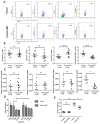Low frequency magnetic fields enhance antitumor immune response against mouse H22 hepatocellular carcinoma
- PMID: 24278103
- PMCID: PMC3835892
- DOI: 10.1371/journal.pone.0072411
Low frequency magnetic fields enhance antitumor immune response against mouse H22 hepatocellular carcinoma
Abstract
Objective: Many studies have shown that magnetic fields (MF) inhibit tumor growth and influence the function of immune system. However, the effect of MF on mechanism of immunological function in tumor-bearing mice is still unclear.
Methods: In this study, tumor-bearing mice were prepared by subcutaneously inoculating Balb/c mice with hepatocarcinoma cell line H22. The mice were then exposed to a low frequency MF (0.4 T, 7.5 Hz) for 30 days. Survival rate, tumor growth and the innate and adaptive immune parameters were measured.
Results: MF treatment could prolong survival time (n = 28, p<0.05) and inhibit tumor growth (n = 9, p<0.01) in tumor-bearing mice. Moreover, this MF suppressed tumor-induced production of cytokines including interleukin-6 (IL-6), granulocyte colony- stimulating factor (G-CSF) and keratinocyte-derived chemokine (KC) (n = 9-10, p<0.05 or 0.01). Furthermore, MF exposure was associated with activation of macrophages and dendritic cells, enhanced profiles of CD4(+) T and CD8(+) T lymphocytes, the balance of Th17/Treg and reduced inhibitory function of Treg cells (n = 9-10, p<0.05 or 0.01) in the mice model.
Conclusion: The inhibitory effect of MF on tumor growth was related to the improvement of immune function in the tumor-bearing mice.
Conflict of interest statement
Figures







Similar articles
-
[Application of a tumor cell vaccine transfected with GM-CSF/IL-2 fusion gene for specific immunotherapy of hepatocellular carcinoma].Nan Fang Yi Ke Da Xue Xue Bao. 2008 Feb;28(2):188-92. Nan Fang Yi Ke Da Xue Xue Bao. 2008. PMID: 18250039 Chinese.
-
[Construction of recombinant plasmid pIRES-GM-CSF-IL-21 and its therapeutic effect on orthotopically transplanted liver cancer in mice].Zhonghua Zhong Liu Za Zhi. 2011 Sep;33(9):661-5. Zhonghua Zhong Liu Za Zhi. 2011. PMID: 22340045 Chinese.
-
Effect of low frequency magnetic fields on melanoma: tumor inhibition and immune modulation.BMC Cancer. 2013 Dec 6;13:582. doi: 10.1186/1471-2407-13-582. BMC Cancer. 2013. PMID: 24314291 Free PMC article.
-
Scutellaria barbata D. Don extract inhibits the tumor growth through down-regulating of Treg cells and manipulating Th1/Th17 immune response in hepatoma H22-bearing mice.BMC Complement Altern Med. 2017 Jan 13;17(1):41. doi: 10.1186/s12906-016-1551-9. BMC Complement Altern Med. 2017. PMID: 28086772 Free PMC article.
-
Effective inhibition of a Strongylocentrotus nudus eggs polysaccharide against hepatocellular carcinoma is mediated via immunoregulation in vivo.Immunol Lett. 2011 Dec 30;141(1):74-82. doi: 10.1016/j.imlet.2011.08.001. Epub 2011 Aug 30. Immunol Lett. 2011. PMID: 21893096
Cited by
-
Integrating electromagnetic cancer stress with immunotherapy: a therapeutic paradigm.Front Oncol. 2024 Aug 6;14:1417621. doi: 10.3389/fonc.2024.1417621. eCollection 2024. Front Oncol. 2024. PMID: 39165679 Free PMC article.
-
Progressive Study on the Non-thermal Effects of Magnetic Field Therapy in Oncology.Front Oncol. 2021 Mar 17;11:638146. doi: 10.3389/fonc.2021.638146. eCollection 2021. Front Oncol. 2021. PMID: 33816280 Free PMC article. Review.
-
LF-MF inhibits iron metabolism and suppresses lung cancer through activation of P53-miR-34a-E2F1/E2F3 pathway.Sci Rep. 2017 Apr 7;7(1):749. doi: 10.1038/s41598-017-00913-2. Sci Rep. 2017. PMID: 28389657 Free PMC article.
-
Gradient Rotating Magnetic Fields Impairing F-Actin-Related Gene CCDC150 to Inhibit Triple-Negative Breast Cancer Metastasis by Inactivating TGF-β1/SMAD3 Signaling Pathway.Research (Wash D C). 2024 Feb 28;7:0320. doi: 10.34133/research.0320. eCollection 2024. Research (Wash D C). 2024. PMID: 38420580 Free PMC article.
-
Glycocalyx transduces membrane leak in brain tumor cells exposed to sharp magnetic pulsing.Biophys J. 2023 Nov 21;122(22):4425-4439. doi: 10.1016/j.bpj.2023.10.020. Biophys J. 2023. PMID: 37992690 Free PMC article.
References
-
- Davanipour Z, Sobel E (2009) Long-term exposure to magnetic fields and the risks of Alzheimer’s disease and breast cancer: Further biological research. Pathophysiology 16(2–3): 149–156. - PubMed
-
- Hug K, Grize L, Seidler A, Kaatsch P, Schüz J (2010) Parental occupational exposure to extremely low frequency magnetic fields and childhood cancer: a German case-control study. Am J Epidemiol 171(1): 27–35. - PubMed
-
- Chung MK, Yu WJ, Kim YB, Myung SH (2010) Lack of a co-promotion effect of 60 Hz circularly polarized magnetic fields on spontaneous development of lymphoma in AKR mice. Bioelectromagnetics 31(2): 130–139. - PubMed
-
- Lee HJ, Gimm YM, Choi HD, Kim N, Kim SH, et al. (2010) Chronic exposure of Sprague-Dawley rats to 20 kHz triangular magnetic fields. Int J Radiat Biol 86(5): 384–389. - PubMed
Publication types
MeSH terms
Substances
LinkOut - more resources
Full Text Sources
Other Literature Sources
Medical
Research Materials

